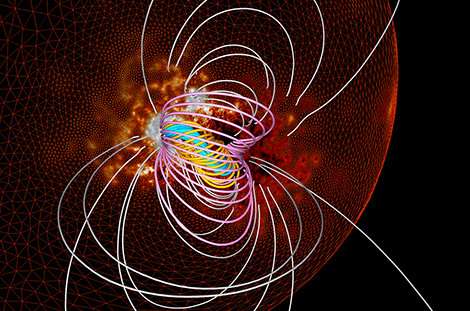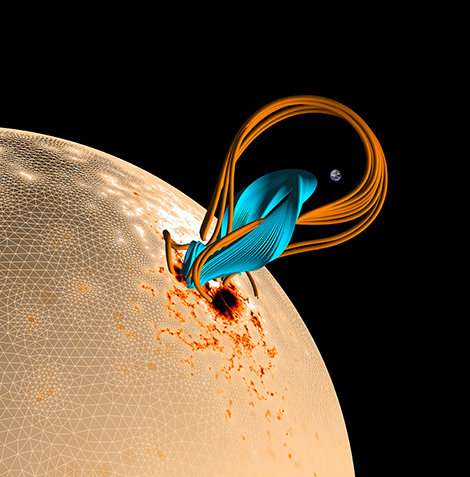Toward a better prediction of solar eruptions

A single phenomenon may underlie all solar eruptions, according to researchers from the CNRS, École Polytechnique, CEA and INRIA in an article featured on the cover of the February 8 issue of Nature. They have identified the presence of a confining 'cage' in which an entangled magnetic 'rope' forms, causing solar eruptions. It is the resistance of this cage to the attack of the rope that determines the power and type of the upcoming flare. This work has enabled the scientists to develop a model capable of predicting the maximum energy that can be released during a solar flare, which could have potentially devastating consequences for the Earth.
Just as on Earth, storms and hurricanes sweep through the atmosphere of the sun. These phenomena are caused by a sudden, violent reconfiguration of the solar magnetic field, and are characterized by an intense release of energy in the form of light and particle emissions, and sometimes by the ejection of a bubble of plasma. Studying these phenomena, which take place in the corona (the outermost region of the sun), will enable scientists to develop forecasting models, just as they do for the Earth's weather. This should limit our technological vulnerability to solar eruptions, which can impact a number of sectors such as electricity distribution, GPS and communications systems.
In 2014, researchers showed that a characteristic structure, an entanglement of magnetic force lines twisted together like a rope, gradually appears in the days preceding a solar flare. However, until recently, they had only observed this rope in eruptions that ejected bubbles of plasma. In this new study, the researchers studied other types of flare, the models of which are still being debated, by undertaking a more thorough analysis of the solar corona, a region where the sun's atmosphere is so thin and hot that it is difficult to measure the solar magnetic field there. They did this by measuring the stronger magnetic field at the surface of the sun, and then using these data to reconstruct what was happening in the solar corona.

They applied this method to a major flare that developed over a few hours on October 24, 2014. They showed that, in the hours before the eruption, the evolving rope was confined within a multilayer magnetic 'cage.' Running evolutionary models on a supercomputer, they showed that the rope had insufficient energy to break through all the layers of the cage, making the ejection of a magnetic bubble impossible. Despite this, the high twist of the rope triggered an instability and the partial destruction of the cage, causing a powerful emission of radiation that led to disruptions on Earth.
Thanks to their method, which makes it possible to monitor the processes taking place in the last few hours leading up to a flare, the researchers have developed a model to predict the maximum energy that can be released from the observed region of the sun. The model showed that for the 2014 eruption, a huge ejection of plasma would have occurred if the cage had been less resistant. This work demonstrates the crucial role played by the magnetic 'cage-rope' duo in controlling solar eruptions, as well as being a new step towards early prediction of such eruptions, which will have potentially significant societal impacts.
More information: Tahar Amari et al, Magnetic cage and rope as the key for solar eruptions, Nature (2018). DOI: 10.1038/nature24671
Journal information: Nature
Provided by CNRS





















